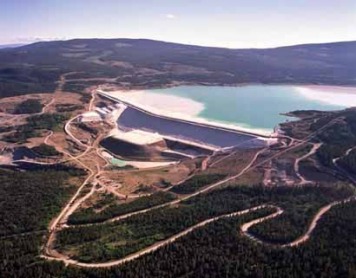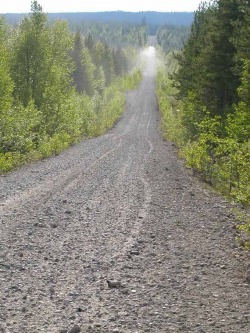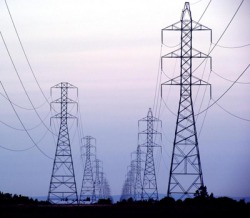Infrastructure
To properly explain the infrastructure, we would like to define the problem of acid rock drainage first. This problem is responsible for some of the infrastructure needed for this project.
Acid Rock Drainage

One of the main impacts to deal with during the mine exploitation of the Galore Creek is the possibility of acid rock drainage or acid generating rocks. This is a process that occurs when sulphide minerals react with both oxygen and water to form sulphuric acid. This reaction can take a few months to many decades to be produced. To remediate to this problem, oxygen or water has to be out of contact with the mineral. There is two ways in doing so; subaqueous disposal (under water) where there is no oxygen or store on land where you limit the contact with water. In doing so, oxidation is minimized. If unfortunately sulphuric acid is produced, acid rock drainage may leach and contaminate the surrounding ecosystem especially the watersheds and rivers. Therefore, it is important to separate the potentially acid generating rocks from the non acid generating rock to limit its quantity.
For the Galore Creek Mine Project, disposal will be subaqueously. It is more expansive but safer. They are potential acid rock drainage that may be produced during the extraction phase of the ores but also during the construction of the road. If no measures are taken, these acid generating rocks would acidify the rivers causing the death of the aquatic fauna downstream. Moreover, this water would be toxic for the wildlife that drinks into the rivers of the Galore Creek. Humans, especially the Tathlan First Nation, do not take their drinkable water downstream of the mine; therefore no predicted impacts from acid rock drainage can directly affect them.
To limit these impacts, some mitigation measures were taken by the proponents. They committed to have a plan for the management and the monitoring of the acid rock drainage materials along the road and from the open pits using an on going site laboratory. They also committed to set up a monitoring program to assess acid rock drainage as short and long term effect. Also, they will submerge all potential acid generating rocks into a tailing dam (permanent submersion under water to limit exposure to oxygen) designed for it. Finally, as an extreme resort, they may add limestone to neutralize the acidic water.
Critique
The critiques for this part concern mainly the post closure and the way they determine if rocks are acid generating. They had two test works to determine the acid generating rocks; phase one showed that the whole tailings can potentially be acid generating whereas the second phase suggested will not be acid producing for the five first years. So, it would have been interesting to know if they used the same approach to get these two different conclusions. A good point is that they used a conservative approach by storing all the potential acid producing rocks. Therefore, their management and monitoring plans for the assessment of the acid rock drainage seems complete but we remain sceptical about the post closure since no one will live on site.
Infrastructure
1. Dam
2. Transport (road, aerodrome, heliport)
3. Pipelines
4. Power transmision line
5. Filter plant
6. Accommodation facilities and other storage areas
1. Dam

As mentioned earlier, the extraction of the ores by the open pits will generate enormous quantity (up to one million) of waste rocks. Among that number, some can be acid generating. Rocks that are safe or not acid generating, they will be stored subaerially upstream in waste dumps. For the acid producing rocks, they will be submerged into water, downstream of the waste dumps, and a dam will assure this disposal and prevent further acid rock drainage. In total, eleven potential tailings disposal sites have been suggested but the final choice was to build it at the Galore Creek Valley, next to the open pits. This choice was based on environmental safety, geotechnical stability, the volume capacity, and the cost. This location will limit the possibility of contamination along the road. The dam itself will be made of non acid generating rocks and a geotextile at the bottom. It length will be a little bit more than one kilometer long and 30 meters thick. The dam construction respects the Canadian Dam Association Safety Guidelines with withstand a 1 in 10,000 year earthquake and accommodate a class five snow avalanche. Post-closure, 16 meters of water will submerge the potential acid generating rocks retained by the dam.
Although it is a mitigation measures by itself since it reduces the possibility of acid rock drainage, the tailings dam has also an impact on its environment. It has been predicted that the dam will lower the water flows and disturb the wildlife habitat as the other component of the infrastructure will do. Moreover, if an accident or a break occurs, there is a possibility of leakage and contamination downstream of the dam. In case of flooding or excess of water due to rain and snow melting, they have foreseen diversion channels to prevent the integrity of the dam and along the diversion channels, there will be energy dissipation structures and sediment traps .For droughts, the will pump water out of the river into the dam to protect the acid generating rocks. In addition for flooding, erosion of the soil may affect the dam integrity but there was no mitigation measures addressed on that subject in the EIA as well as for the loss of wildlife habitat.
However, the proponent committed to treat the leakage of the problematic water if an accident occurs in order to meet the Environmental Management Act and the Federal Metal Mining Effluent Regulations. They also committed to monitor the dam integrity during the operation and post-closure, on an annual basis. The also did modeling for the probability of environmental risks (see Risk Assessment Section). They will also have a plan for remediation of the contamination in case of accident.
The construction of the dam is overall beneficial for the environment. However, the possibility of leakage is of the most concerns. On that, in 2007, the Natural Resources of Canada found a major fault beneath the main tailings dam but the proponent concluded that the fault was narrow, appeared relatively impervious and not considered a t detriment to the dam integrity.
Critique
The construction of the dam is overall beneficial for the environment. However, the possibility of leakage is of the most concerns. On that, in 2007, the Natural Resources of Canada found a major fault beneath the main tailings dam but the proponent concluded that the fault was narrow, appeared relatively impervious and not considered a t detriment to the dam integrity.
2. Transport (road, aerodrome, heliport)

The Galore Creek Valley is isolated from any road. Therefore, and access road was a priority to build in order to reach the site. For the heavy material and the transport of workers, a heliport/aerodrome was also built. At the beginning, seven options for the road were available but after feasibility studies, only the northern road option and the southern road option were retained even if it requires bridges and tunnel. For the Aerodrome, three alternatives were suggested but the final site is located near the Porcupine River, will have 3 km in length.
For the road, the predicted impacts was dusting or release of mineral along the road, disruption of ecosystems, erosion and compaction of the soil and wildlife collision. Moreover, the erosion may produce acid generating rocks and cause water quality issues (see Acid Rock Drainage Section). Geohazards is also a probability to cause accident as well as other natural environmental effect; more details are detailed in the Risk Assessment Section. For the aerodrome, the predicted impacts are the noise but also the disturbance and disruption of the surrounding ecosystems.
Mitigation measures addressed for the road were habitat mapping, monitoring for metal contamination along the road (possibility of leakage of the trucks), and the use of pipelines of the transport of the slurry and diesel. The public consultation also played a role for the location of the road; with their Traditional Ecological Knowledge (TEK), they demonstrated that the southern road was more damageable than the northern road for wetlands and fisheries, especially for salmon. They also limited on road transport by setting up two pipelines; one for the slurry concentrate and the other for the import of diesel. In addition, they will implement a road maintenance program during extreme weather conditions. There was no mitigation measures provided for the site of the heliport/aerodrome but they followed and met the requirements of Aeronautics Act and Canadian Aeronautics Regulations.
Critique
My critique for the road is positive; the proponent respected the TEK of the First Nations even though the capital cost of this choice was higher. However, they did not mention how many trucks will be on the road on a daily basis and they have not calculated their CO2 emissions from these trucks. Concerns about the traffic in Stewart have been raised but mitigation measures were not addressed in the report. On the other hand, there was insufficient information and no mitigation measures for the heliport/aerodrome located near the Porcupine River. However, the burning of kerosene and the release of de-icing fluids event if there is a recycling program.
3. Pipelines

After the minerals have been extracted from the ores, the grounded minerals are mixed with water (the slurry) to be exported outside of the camp. In addition, the import of diesel will also be transported by pipeline. Although pipelines can have an impact on its environment, here it is a mitigation measure by itself. It reduces the number of trucks (up to 50 trucks per day) on the access road and therefore the chance of accidents. The pipelines will follow the access road and be made of double walls. There is also a whole set of detection system along the pipeline with five monitoring stations, a collective basin, an emergency drain and a few shut off valves. Trained personnel will also be formed in case of a spill. It is projected that the slurry circulation will be about 90 tones per hour. The pipelines can be on ground or buried but for this project, they chose the buried option.
The introduction of pipelines into a site triggers impacts on its ecosystem. The main impacts are about the disturbance of the soil temperature, the soil compaction and erosion and the possibility of leakage and rupture.
Some mitigation measures have been addressed to limit these impacts. The underground pipelines have been showed to have a lower disturbance on the ecosystem than above ground pipelines but also it is less damageable for the pipelines themselves in terms of geohazards, avalanches, and corrosion. When the pipelines need to cross rivers, they will be attached to the bridges and be more insulated. These buried pipelines eliminate the risk of wildlife collision
However, some questions remain unanswered; since the liquid circulating in the pipelines will be above zero, the soil temperature will probably be disturbed, since the heat of the pipelines are likely to keep soil from freezing, but no consideration of that point was addressed on the report. Concerning the clean up methods in case of a spill, no mention about the procedures were described in the report but it should be since the probability of a spill for these 20 years non stop is high.
Critique
Although there is a possibility of pipeline rupture, which may lead to environmental contamination, pipelines are safer than trucks for the transport of both the slurry and diesel even though its capital cost is higher compared to truck transportation. However, the annual operating costs are lower and the magnitude of the environmental effects is significantly reduced.
4. Power transmission line

Two types of energy will be used at the mill, fossil fuel (diesel) and electricity. The electricity is generated by hydroelectrical turbines from Bob Quinn Lake grid which is owned by Hydro B.C. They will import electricity by a power transmission line that will follow the access road from the highway 37. Hydroelectricity was chosen because of its reliability and its capacity to supply the mine facilities with 80MW. It was the best option in terms of cost, environmental impacts, and feasibility.
A transmission line across 125 km of forest has impacts on the environment. It might disturb wildlife habitat de to deforestation and it deteriorates the landscape. Unfortunately, the proponent did not provide any mitigation measures for this component of the infrastructure because it is a green energy but setting the power line along the road reduces deforestation and in case a repair, the line will be easy to get to which can also minimize construction and maintenance cost.. Between you and me, diesel will also be used at the mill which means that they are not totally green. Thus, there was no mitigation measure in the EIA.
Critique
For the critique of the power transmission line, we would have like to know if the cost of the transmission line is split between the proponent and Hydro BC since the source of electricity is held by Hydro BC. Is there a share of the cost? In addition, if we read between the lines, it would have seen that the transmission line carries more energy than needed at the mill. Does it mean that something else is coming to the Galore Creek or is the mine enlarge?
5. Filter plant
The filter plan of the dewatering facility is located outside of the Galore Creek Valley. This facility will accept the slurry concentration from the pipeline dewater (80 m3 per second) it and transported to the Port of Stewart for shipment. The steps of the treatment include flocculation, settling, fine filtering, the removal of dissolved organics and the adjustment of the pH. This treated water will discharge into the river.
Many predicted impacts have been raised with this treated water. I will give you an overview of these impacts but they are discussed deeper in the hydrological section. The main impact is on the aquatic ecosystem especially on the fish. There may have uncontrolled or accidental release of materials into the environment and may cause direct and indirect morbidity but not mortality among fish population. There is also a potential for the downstream vegetation and wildlife to uptake metals that cannot be treated with the filter plant but these effects are not anticipated. Negative effects on insects, wildlife, and wetlands may also been perceived downstream of the filter plant. The insect population may fall; intoxication of the wildlife that drinks this water if an accident occurs may arise and; wetland would be lost. The noise that the filter plant will generate may disturb the wildlife and finally, there were some concerns about the visual looking of the filter building which may deteriorate the visual landscape.
However, the proponent committed to respect the B.C. Water Quality Guidelines and based on the best available scientific data, including modeling, the probability and the severity of discharge are judged negligible and the probability of an accidental failure remains very low. However, the mitigation measures were the treatment itself to respect the environmental standards.
There is no real critique of this point since they use conventional mitigation to treat water and the presence of the filter plant is necessary for the mining process.
6. Accommodation faciliies and other storage areas
The proponent will build on-site work camp for workers that live outside of the region. The facilities, located at the Galore Creek Valley, will lodge workers and take care of them. It includes a cafeteria, a laboratory, a fitness room and the rooms can accommodate 850 persons in total. Finally, to prevent risks, an explosive storage will be build at the Galore Creek Valley but far from the accommodation facilities in order to limit damage in case of explosion. These explosives will be used for the pits but also for the management of avalanches.
WRITTEN BY: JULIE MÉNARD
Last updated: April 16th, 2008
References:
NRSC 437 Lecture notes
http://www.eao.gov.bc.ca/epic/output/html/deploy/epic_document_239_23630.html
